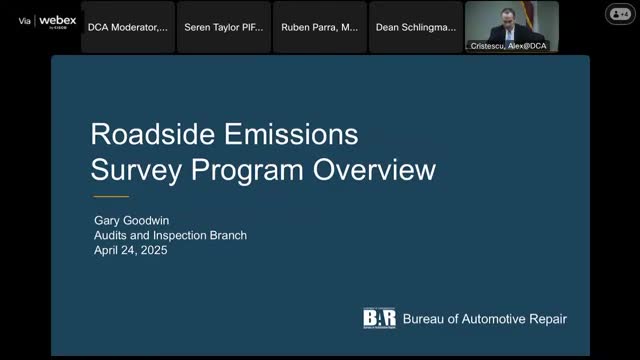California Roadside Emissions Survey Program aims to enhance smog check effectiveness
April 25, 2025 | Respiratory Care Board of California, Boards and Commissions, Executive, California
This article was created by AI summarizing key points discussed. AI makes mistakes, so for full details and context, please refer to the video of the full meeting. Please report any errors so we can fix them. Report an error »

Under the bright lights of a government meeting room, officials gathered to discuss a vital initiative aimed at improving air quality across California. The Bureau of Automotive Repair (BAR) presented an overview of its Roadside Emissions Survey Program, a key component in the state's ongoing efforts to evaluate and enhance the effectiveness of the smog check program.
Gary Goodwin, stepping in for the scheduled presenter, outlined the program's purpose: to collect data that supports California's smog check initiatives while ensuring compliance with both federal and state regulations. The program, which operates with the assistance of the California Highway Patrol, is designed to assess vehicle emissions in areas known for high traffic and air quality concerns, such as the Central Valley and the Greater Los Angeles Basin.
Participation in the survey is entirely voluntary, with no personal information collected from drivers. Goodwin emphasized that the roadside emissions tests are not comprehensive smog checks but rather focused on gathering specific emissions data. The process is quick, taking less than five minutes, and is intended to minimize disruption for motorists. Participants receive a Vehicle Inspection Report (VIR) detailing any emissions data collected, along with information on safety recalls and potential vehicle issues.
The meeting also highlighted the importance of transparency and safety during these surveys. Survey sites are clearly marked, and local authorities are notified in advance to ensure public awareness. Goodwin reassured attendees that the program is designed with safety as a top priority, both for the survey teams and the motoring public.
As the discussion progressed, advisory group members raised questions about the program's operational details, including how vehicles are selected for testing and the implications of the data collected. It was revealed that approximately 10,000 roadside tests are conducted annually, with a refusal rate of about 30 to 40 percent. Interestingly, many drivers who decline to participate do so for reasons unrelated to vehicle condition, such as time constraints.
The meeting concluded with public comments, including a poignant testimony from a long-time smog test technician. He shared experiences of informing drivers about safety issues with their vehicles, underscoring the dual role of the program in promoting environmental health and public safety.
As California continues to grapple with air quality challenges, the Roadside Emissions Survey Program stands as a proactive measure, engaging the public in the fight against pollution while fostering a culture of vehicle safety. The insights gained from this initiative will not only inform regulatory practices but also contribute to a cleaner, healthier environment for all Californians.
Gary Goodwin, stepping in for the scheduled presenter, outlined the program's purpose: to collect data that supports California's smog check initiatives while ensuring compliance with both federal and state regulations. The program, which operates with the assistance of the California Highway Patrol, is designed to assess vehicle emissions in areas known for high traffic and air quality concerns, such as the Central Valley and the Greater Los Angeles Basin.
Participation in the survey is entirely voluntary, with no personal information collected from drivers. Goodwin emphasized that the roadside emissions tests are not comprehensive smog checks but rather focused on gathering specific emissions data. The process is quick, taking less than five minutes, and is intended to minimize disruption for motorists. Participants receive a Vehicle Inspection Report (VIR) detailing any emissions data collected, along with information on safety recalls and potential vehicle issues.
The meeting also highlighted the importance of transparency and safety during these surveys. Survey sites are clearly marked, and local authorities are notified in advance to ensure public awareness. Goodwin reassured attendees that the program is designed with safety as a top priority, both for the survey teams and the motoring public.
As the discussion progressed, advisory group members raised questions about the program's operational details, including how vehicles are selected for testing and the implications of the data collected. It was revealed that approximately 10,000 roadside tests are conducted annually, with a refusal rate of about 30 to 40 percent. Interestingly, many drivers who decline to participate do so for reasons unrelated to vehicle condition, such as time constraints.
The meeting concluded with public comments, including a poignant testimony from a long-time smog test technician. He shared experiences of informing drivers about safety issues with their vehicles, underscoring the dual role of the program in promoting environmental health and public safety.
As California continues to grapple with air quality challenges, the Roadside Emissions Survey Program stands as a proactive measure, engaging the public in the fight against pollution while fostering a culture of vehicle safety. The insights gained from this initiative will not only inform regulatory practices but also contribute to a cleaner, healthier environment for all Californians.
View full meeting
This article is based on a recent meeting—watch the full video and explore the complete transcript for deeper insights into the discussion.
View full meeting
